For many months now, I’ve been thinking of doing a series on Best Planned Neighborhoods of Pakistan. When I think about it, quite a few come to mind e.g. The whole city of Islamabad, North Nazimabad, Karachi, Model Town, Lahore, etc. However one locality that has always caught my attention for its visionary town planning is the Clock Tower and 8 bazaars of Faisalabad. Though it was planned more than 100 years ago, the symmetry and simplicity of design of these 8 bazaars have always fascinated me. The roads of 8 bazaars now seem narrow for the volume of traffic that runs on Faisalabad roads, but I believe a hundred years ago, this must’ve been a marvel of town planning.
Following is a satellite image of Fiasalabad’s Clock Tower and the 8 bazaars laid around it in the shape of British Union Jack.

At present the buildings located in 8 bazaars and the Clock Tower itself are mostly in a state of disrepair.
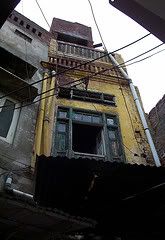 Like every major city of the world, as population of Faisalabad grew, businesses and residences moved out to suburbs leaving downtown to become one large commercial storage space. Very few people live in the 8 bazaars now but its commercial importance has not waned yet.
Like every major city of the world, as population of Faisalabad grew, businesses and residences moved out to suburbs leaving downtown to become one large commercial storage space. Very few people live in the 8 bazaars now but its commercial importance has not waned yet.
Photo to the left shows 19th century architecture in Jhang bazaar which has gone out of fashion for residential units. People have moved out of bazaars to the city suburbs
The Eight bazaars of Faisalabad are called: Aminpur bazaar, Katchery bazaar, Karkhana bazaar, Jhang bazaar, Bhawana bazaar, Rail bazaar, Chiniot bazaar and Mintgumry bazaar (named after Montgomery).
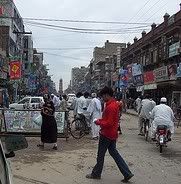 The photo to the right is a street scene of ‘Jhang bazaar’. You should be able to locate a monolithe looking Clock tower in this photo.
The photo to the right is a street scene of ‘Jhang bazaar’. You should be able to locate a monolithe looking Clock tower in this photo.
Because of the geometry of town planning here, one sees a full face of Clock Tower from 4 perpendicular bazaars. I believe they are Aminpur Bazaar, Jhang bazaar, katchery bazaar and karkhaana bazaar. But from the 4 diagonal bazaars, only the diagonal corners of the Clock Tower are visible. The four diagonal bazaars are called Bhawana bazaar, Rail bazaar, Chiniot bazaar and Mintgumry bazaar. During my childhood visits to the Faisalabad it was always a fascination to try to guess the name of a bazaar, looking at what side or corner of the Clock Tower was visible to us. That fascination went away once I could start remembering the bazaars from their shops and other landmarks.
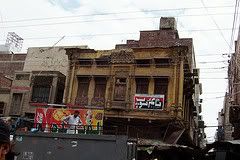 It is said that the modern city of Faisalabad came into existrence around 1880 when a proper city was designed by one Captain Pophan Young. I am unable to find if Captain Young also designed the 8 bazaars or not. The only one source of such data on web attributes the design of 8 bazaars to the famous philanthropist Sir Ganga Ram and it is said:
It is said that the modern city of Faisalabad came into existrence around 1880 when a proper city was designed by one Captain Pophan Young. I am unable to find if Captain Young also designed the 8 bazaars or not. The only one source of such data on web attributes the design of 8 bazaars to the famous philanthropist Sir Ganga Ram and it is said:
Sir Ganga Ram was assigned to draft its plan. After approval of draft Sir Ganga Ram was given five squares of lane as reward.
Can some reader authenticate this claim about Sir Ganga Ram?
![]()
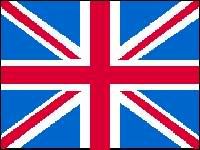 The planned city was then named as Lyallpur, after the British Lieutenant Governor of the Punjab, Sir Charles James Lyall. The 8 bazaars were planned in the shape of the Union Jack to commemorate the long reign of Queen Victoria of England.
The planned city was then named as Lyallpur, after the British Lieutenant Governor of the Punjab, Sir Charles James Lyall. The 8 bazaars were planned in the shape of the Union Jack to commemorate the long reign of Queen Victoria of England.
The actual work on the construction of Clock Tower started after its foundation stone was laid on November 14, 1903 by Sir Charles Pewaz, the then governor of Punjab. The plaque of the foundation stone was prepared by metal art experts of Chennai, Yangon and Colombo.
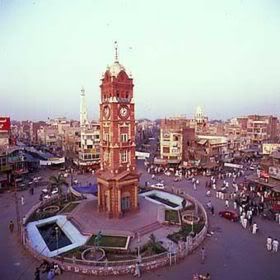 As the story goes, there used to be a beautiful park at the centre point of the eight bazaars and a well in the middle of the park. The site of the well had been selected for constructing the Clock Tower. To build the Clock Tower, that well was filled. The filling of the well took weeks. The earth for the filling was collected from Chak Ram Dewali (located on present day Sargodha Road).
As the story goes, there used to be a beautiful park at the centre point of the eight bazaars and a well in the middle of the park. The site of the well had been selected for constructing the Clock Tower. To build the Clock Tower, that well was filled. The filling of the well took weeks. The earth for the filling was collected from Chak Ram Dewali (located on present day Sargodha Road).
Red sand stone was obtained from Sangla Hill. Expert sculptors which included one Gulab Khan who belonged to the family who built Taj Mahal in Agra, installed big blocks of red sand stone after proper dressing and sizing them.
Expert carpenters were also involved in the construction and beautification of the tower. Big wooden planks were installed without being saw-cut into nets and fixed in the doors and windows of the tower. The clock for the tower was brought from Mumbai. The work was completed in Dec, 1905 and the whole construction cost came out to be Rs 40,000.
Sir Lion Toper, the then finance commissioner, performed the formal inauguration of the Clock Tower in the presence of hundreds of citizens of Lyallpur by stepping onto the balcony of the tower. By the time this tower was built the eight bazaars were already inhabited and functional.
 The 8 bazaars cover a total area of 110 acres . All these eight bazaars are also connected with each other through a circular road (also a bazaar) called the Gol Bazaar.
The 8 bazaars cover a total area of 110 acres . All these eight bazaars are also connected with each other through a circular road (also a bazaar) called the Gol Bazaar.
The monument shown to the right is located just outside the Rail bazaar. It is called Gumti. It is now part of a traffic circle. It also dates back to British era. I am unable to find exact date of its construcution. One source says early 1900s.
To Reduce Congestion Around Bazaars: The Lyallpur Town Administration, on December 10, 2005, imposed a ban on the entry of slow-moving vehicles which included donkey-carts, tongas and motorcycle-rickshaws. The ban’s jurisdiction included eight bazaars around the Clock Tower and adjoining commercial centres. (Reference 6 below)
Personal Memories:
I have some vague and some vivid memories of visiting the Clock Tower and the 8-bazaars in my childhood and teenage. I do remember one of the tastiest home made mango ice cream is sold infront of Clock Tower. I think the ice cream shop was between Aminpur bazaar and Bhawana bazaar. There were also several ‘Carrot juice’ shops around the Clock Tower that used to do roaring business in winters. I remember a long line of stationery stores in Aminpur bazaar. One shop called ‘ASCO sports’ in Kutchehry bazaar was very dear to me because I always used to buy cricket bats from there which became very popular among my team mates in Karachi. I don’t know if ASCO sports is still there. Can a authentic Faisalabadi confirm that?
References and Credits:
1. City District Government Faisalabad
2. World66.com Travel Guide on Faisalabad– The history of Faisalabad given at this site is the one which is copied all over the web. Needs second source.
3. Satellite Image from googleearth.com
4. Sunaina Suneja at flickr.com for Jhang Bazaar photos
5. Faisalabad Clock Tower Photo is from wikipedia
6. Dawn News on ban of slow traffic in bazaars here



















































Well here we have another example of chronic levels of inferiority complex amongst Pakistanis. Going as far as building a town in the shape of the British union jack! Our collonial masters of the past would surely love this if they were alive today.
As for today, I’m pretty sure this would bring a smile to the face of BNP leader Nick Griffin, while he simultaneously rallies up support in Britain to expel all immigrants including Pakistanis.
MashaAllah
Vry well planned city with an accomodatory outlook,Faisalabad is the third largest city of Pakistan within its age of about 100 years.
Its amazing to know that it has surpassed big cities of Multan,Hyderabad,Rawalpindi,n many others.
But even then it really needs a timely planning for traffic n pollution control.But keep in mind that its population can not be controlled.
Dear Lutful Islam. Great recap. I enjoyed reading your anecdotes of Ghanta ghar and adjoining bazaars. Yes, I believe the ice cream shop I mentioned in my post is the ‘But’s Ice Cream’ shop.
As a graduate from Jamia Zariya Daisia (University of Agriculture, Faisalabad) my ties with ghanta ghar and eight bazaars are very strong. I am not a Punjabi, but Faisalabad is my second home. Students of the University have a love-relationship with the eight bazaars. You have to walk a couple of miles to get there. And the purpose of this walk is usually a “penalty” that you have to fulfill in the form of Ice cream or Parathay for the gang of friends who found you guilty of some daft crime. A couple of cinemas are in close vicintiy, if you wish to watch the latest film. I usually went along in the summers for the airconditioning.
I have live in a house in Aminpur bazaar for a few weeks. The sounds and smells are still fresh. The faisalabadi accent and the cutting sense of humour in the form of “Jugats” were a lovely combination. The smell of frying “ghewar” in the street and endless pharmacy shops of gol bazaar. Ghewar is apparently made only in faisalabad. Full of calories and bad fat, its delicious! . I remember going to one Wahabi mosque in Aminpur bazaar with a friend. On the top floor, they had a langar open and these guys were volunteers. During the course of the evening, I had heard the funniest exchange of Jugats in my life. The group of friends, which included long bearded Allama types as well as clean-cut graduates, had let loose a torrent of insults upon each other. It was the first time I had heard punjabis in their element, doing what they loved to do. And it changed my perception of the region forever. I could not suppress my laughter, but trust me I had never tried harder. I must say, none of jokes that day had any abnoxious content and I was amazed at the utter innocence and pointlessness of the whole exercise. But I loved it.
Katchehry Bazaar is home to the famous “Jahangir Murgh pulao”. Late Nusrat Fateh Ali khan used to come here all the way from his village to enjoy the rice during his younger days. I thought the quality was mediocre. But being a Kashmiri, I believe that Punjabis can not cook rice. There is a series of ice-cream parlours in the main chowk, under the ghanta ghar. I remember going to Butt’s ice-cream shop. The proprieter was a huge figure, who sat on his platform, surrounded by tubs of various flavours of ice-creams and platters of kheer. I never saw him move, or walk during the countless trips we made to his shop. Although one of my friends swears that he saw Butt sahib get up and walk away once. Rest of us do not believe him.
During winters, Faislabad is usually covered in a blanket of fog. It is bitterly cold. At the corner of Kutchehry Bazaar in from early evening Paratha stalls appear. Their massive Tawwas and wide range of stuffed parathas are a welcome sight for the hungry students. Good thing is, they are open until dawn. Many a nights, we had walked to ghanta ghar, wrapped in our chaddars (some even came in blankets) to enjoy the hot, crispy and huge parathay, dripping with ghee and served with pickle or chickpea curry.
Unfortunately, ghanta ghar is devoid of any famous tea stalls. There was this seedy, one star hotel tea room which served separate tea, which was not as nice as the golden, syrupy tea available elsewhere. There is plenty to remember about ghanta ghar, but I think my experiences are only relevent to those who went to the UAF. Residents of Layallpur will have a different perception of their city.
Owais,
An interesting post.I have been to faisalabad a number of times and we used to pass through the chowk.
I can authenticate the claim that this planning was done by Sir Ganga ram as I was reading an article about him somewhere and it was mentioned that he was the overall master planner of faisalabad. Faisalabad was built when Sir Ganga ram along with their British counterparts developed this irrigation system and the big canals were built in the Doaba region. He even went to UK for studies and even impressed the Brits there.
His legacy is still there such as Ganga. Ram hospital,Diyal Singh College.